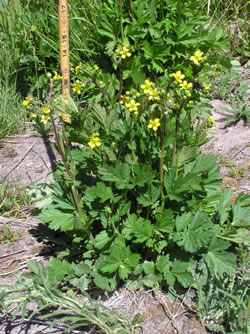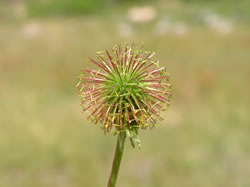Plant of the Week
 Range map of Geum macrophyllum. States are colored green where the species may be found.
Range map of Geum macrophyllum. States are colored green where the species may be found.
 Geum macrophyllum in habit. Photo by Al Schneider.
Geum macrophyllum in habit. Photo by Al Schneider.
 Close-up of the flower head of Geum macrophyllum. Photo by Al Schneider.
Close-up of the flower head of Geum macrophyllum. Photo by Al Schneider.
 Close-up of fruiting heads of Geum macrophyllum, City Creek Canyon, Salt Lake County, Utah. Photo by Al Schneider.
Close-up of fruiting heads of Geum macrophyllum, City Creek Canyon, Salt Lake County, Utah. Photo by Al Schneider.
Large-leaf Avens (Geum macrophyllum)
By Walter Fertig
The genus Geum in the rose family (Rosaceae) contains about 40 species found mostly across the northern hemisphere, but also present in southern Africa and the Andes of South America. At least three different evolutionary clades occur in the genus, and not surprisingly, it is often split into multiple segregate genera. All of the Geum species of North America have enlarged, long persisting styles at the top of each ovary. In some species, the styles are straight and bristly, while in others they have feathery plumes. Geum macrophyllum (large-leaf avens) is distinctive in having a bristly style that has a pronounced curlicue-like twist near the tip, not unlike the tail of a pig. The persistent styles give the fruiting heads of this species a bristly, pincushion-like appearance.
In flower, large-leaf avens closely resemble cinquefoils in the related genus Potentilla. Members of both genera often have bright yellow, 5-petaled flowers and a distinctive calyx appearing to have 10 sepals (there are five true sepals that alternate with five narrower, sepal-like bracts). Cinquefoil flowers lack the long, persistent, twisty styles of Geum. Vegetatively, G. macrophyllum can be recognized by its pinnately compound leaves (most cinquefoils have palmately compound leaves with leaflets arranged like fingers on a palm). The terminal (uppermost) leaflet of large-leaf avens is shaped like a maple leaf and is significantly larger than the other leaflets farther down the leaf blade.
Large-leaf avens has one other unusual floral trait: its solid yellow flowers have a large black spot at the base when seen under ultraviolet light. Humans cannot see this spot under normal lighting conditions because our eyes are not sensitive to ultraviolet radiation, but insects can. Geum is often pollinated by small flies that are drawn to the black spot at the center of the yellow flower in much the same way as an airplane pilot is guided by rows of bright lights along a runway at night. These "nectar guides" are actually found in nearly 33% of all yellow-flowered plants according to one study.
Geum macrophyllum ranges from Alaska to Greenland and south to Michigan, New Mexico, and California. It is relatively common from foothill valleys to the subalpine zone, but is most frequently encountered along wet meadows and streambanks in western mountains.

